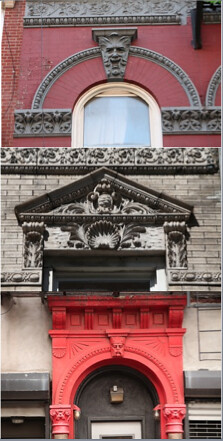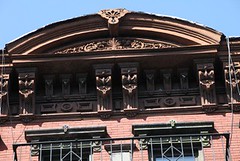 David Jarrett Details from a few of the buildings that would gain protection under the revised historic district plan.
David Jarrett Details from a few of the buildings that would gain protection under the revised historic district plan.The effort to grant historic landmark status to parts of East Village recently received an unexpected boost.
In an apparent response to residents’ concerns, the city has decided to expand a proposed historic district to include an additional block.
The district, which was originally designed to encompass broad swaths of properties along Second Avenue and on 10th Street, now also includes Second Street between First and Second Avenues, as well as new buildings at the corner of Sixth Street and Avenue A.
“The buildings were almost crying out to be included in the district,” said Richard Moses, a member of the Lower East Side Preservation Initiative. “It makes sense to include them, they’re very strong architecturally, and there is a lot of cohesion in the streetscape.”
The decision by the Landmarks Preservation Commission to add the buildings came as State Senator Tom Duane endorsed preservationists’ push for the expanded district.
“Many other buildings not far outside the study areas have architectural, cultural and historic significance and, with neighboring structures, a cumulative ‘sense of place,’ which makes them worthy of consideration,” Mr. Duane wrote in a letter to the commission earlier this month.
If approved, the landmark designation would essentially preserve buildings within the district. Property owners would have to win approval from the commission before making changes to the exterior of their buildings.
“There are some fabulous buildings along Tompkins Square East,” said David Jarrett, who enjoys photographing historic buildings in the Village. “You will not see gems like these anywhere else in Manhattan.”
Thus far, the often-contentious process has met little resistance. But Mr. Moses and other preservationists face a several more steps before the district is approved.
The landmarks designation could come to a vote as soon as July.
Mr. Moses said that he also hopes for further expansion of the landmark district in the future; he envisions a time when the district which would include First Street between First and Second Avenues, the Stomp Theater and the east side of Tompkins Square Park.
“The streetscapes that survived are so evocative of this period of immigration that is so important in our history,” Mr. Moses said.
Mr. Jarrett said he had suffered the consequences of unchecked development in his neighborhood near the U.N. Building on 47th Street.
“I’ve seen my neighborhood change so dramatically,” he said. “Third Avenue is nothing but boring, poorly designed office buildings. Look what happened on the Bowery, developers put up those glass-shelled buildings that only rich people can afford.”




